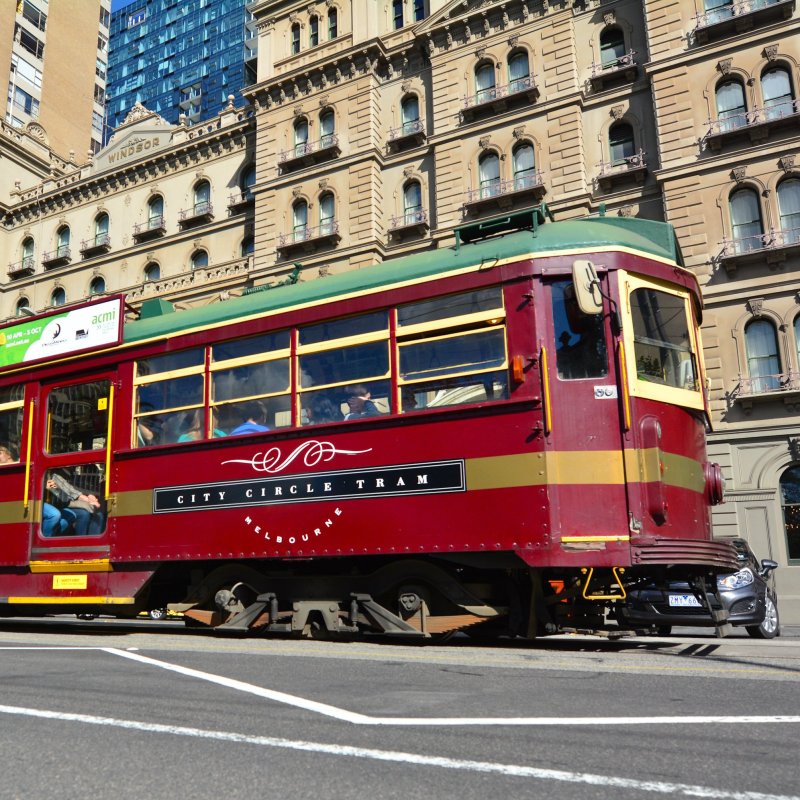
A good chunk of every travel budget is consumed by transport costs — taxis, Ubers, ferries, trains, buses, etc. Sometimes it feels like the only free ride out there is the one we get around the sun each year. But there are some other free rides around the globe that not only lighten traveling costs but offer memorable experiences and unforgettable views. Here are some worth knowing about.
Videos by TravelAwaits

1. New York City’s Staten Island Ferry
New York is one of the most expensive cities to visit in the world. But there’s at least one freebie: The Staten Island Ferry across New York’s harbor, which departs from Manhattan and offers some of the best city views in the world, is free to board.
On this commuter ferry, you can glide past the Statue of Liberty. The trip also offers remarkable views of the harbor, Ellis Island, the jagged Manhattan skyline, and the Brooklyn Bridge. Look out for the Verrazzano-Narrows Bridge, one of the longest suspension bridges in the world, which often appears in overhead shots of the New York City Marathon. The Staten Island Ferry was also a film location in productions such as Working Girl, How to Lose a Guy in 10 Days, and Sex and the City.
Go at night for views of the City That Never Sleeps ablaze with lights, plus a chance to see the Statue of Liberty’s torch shine bright.
The ferry holds 6,000 passengers. For tourists, the best photo opportunities are from the decks. The trip takes 25 minutes, and it’s best to avoid rush hour. You’ll need to disembark and reboard for the return trip.
The Staten Island Ferry runs 24 hours a day, seven days a week, with two to four ferries an hour. You can find the schedule here. The ferry is fully accessible. Be warned that scammers outside the Manhattan terminal might try to sell you tickets, even though the ferry is free.

2. Amsterdam’s Ferries
Amsterdam is home to more bikes than people. Tourists arriving at Centraal Station often photograph the sea of parked bikes outside the station. Most tourists continue through the front of the station to reach the central area with its cafes, museums, and merchant houses. But if you head behind the station, you’ll find a number of free ferries.
Waiting to board is an insight into local transport. The ferries are crammed with bikes, with the occasional Canta microcar wedged between the tangles of handlebars. The routes range from a 2-minute river crossing to a 15-minute ride to the NDSM Wharf, a former shipyard located on the banks of the River IJ. This post-industrial hot spot features street art, artists’ studios in warehouses, and cafes made from shipping containers. On the ferry, you’ll see how Amsterdam is rejuvenating past wastelands. Look up at the Faralda Crane Hotel, where suites perch on top of a towering crane. Glide past the Botel, a dry-docked boat converted into a hotel, and an abandoned Soviet submarine that’s now a canvas for street art.
The Buiksloterweg Ferry goes to the Eye Film Museum, a museum of the moving image. The eye-catching building looks like a giant threw down his hammer and left the sharp angles glinting in the sun. On the night ferry, catch the Eye lit up, when the slit of light looks like the pupil of an eye. Next door is the A’Dam Toren, a high-rise building with a mortarboard hat. Upon closer inspection, you’ll see that it’s a revolving restaurant and home to the Over the Edge experience — Europe’s highest swing, with views over Amsterdam.
Amsterdam’s sunsets are legendary — the water reflects the fiery colors — so sunset ferry rides are always a good option. For routes, click here.

3. Luxembourg’s Free Public Transportation System
Luxembourg is a European country the size of Rhode Island. On March 1, 2020, it became the first country in the world to offer nationwide free public transport.
As one of the three capitals of the European Union, Luxembourg City is modern but with plenty of old-world charm. A growing tram network and regular buses (every 15 minutes on weekdays) serve all quarters. All transport is wheelchair accessible.
On the free transit system, you’ll see public squares dating to the 13th century, cobbled streets, the old walled city, and charming church spires punctuating a medieval fairy-tale setting. Luxembourg City straddles a ravine, with Ville Haute (the historic center) offering views of the river valley below. Inventive transport options have replaced clifftop climbs. The gravity-defying funicular zips up the steep incline in 63 seconds. The Pfaffenthal Panoramic Elevator provides a 55.8-foot drop in 30 seconds that you can see through a glass floor and walls, where The Grund, a historic district below, looks like a model village. The elevator runs on wireless — no cables detract from the authenticity of this UNESCO World Heritage site! After leaving the elevator, follow the signs for the City Shuttle. This robo-bus carries 15 people and has no driver, steering wheel, or pedals. You’re likely to hit the imaginary brake every time you see a pedestrian.
The fairy-tale views continue into the countryside, dotted with 50 castles that can be easily reached on day trips. Take a 60-minute bus ride to visit Echternach, with its medieval old town center, ancient ramparts, pastel-colored houses, seventh-century Benedictine abbey, and beautiful lake. Clervaux, a 60-minute train ride from Luxembourg City, is home to a striking white castle with portions dating to the 12th century. It also houses the photographic exhibition The Family of Man curated by Edward Steichen. Or head to Vianden Castle, an hour and 40 minutes from Luxembourg City via bus and train, to marvel at one of the most stunning Romanesque-Gothic castles in Europe. There’s a chairlift over the castle, and Vianden itself is home to the Victor Hugo House.
Stop off at Diekirch for the National Museum of Military History, famous for its displays on the Battle of the Bulge. Esch-sur-Alzette (25 mins by train from Luxembourg City) is the second-largest town in Luxembourg and boasts stunning architecture by Viollet-le-Duc, Joseph Stubben, and Gottfried Bohm.

4. Melbourne’s City Circle Tram
When my grandson went to live in the United States, I gave him a toy tram as a reminder of his home city. Melbourne has the largest tram network in the world — 160 miles of double track, 24 routes, and 1,763 tram stops. We are attached to our “green rattlers,” even though these have long since been replaced with modern streamlined versions that ghost along the tracks.
The modern Central Business District trams are free. Announcements tell you when you are leaving the free zone and need to get off unless you have purchased a Myki. If you are only spending a day or so in Melbourne, you’ll find that most of the major attractions are within the free zone.
The City Circle Tram is a different free tram service. This hop-on, hop-off tram is meant for tourists, though many locals use it as well; it features recorded information announcing tourist sites. The vintage cars date from 1923 to the 1970s. These old rattlers have steps, and so they are less accessible. They are either dark burgundy with gold trim or dark green, but they’re always marked Number 35 — City Circle Tram.
The circle takes an hour to complete. Stay on board, or get off at attractions. With 10 circling trams, there’s never more than a 12-minute wait, and the cars run in both directions.
The service passes the Flinders Street Railway Station, Australia’s busiest suburban rail terminus and home to the Clocks. To meet someone in Melbourne, we say, “I’ll meet you under the Clocks.” It also passes the contemporary Southern Cross Station, awarded the Royal Institute of British Architects’ Lubetkin Prize in 2007 for the most outstanding building outside the European Union.
Melbourne has wide tree-lined streets and a European air. The commentary on the train tells visitors, “Melbourne is the third-largest Greek city in the world, and it has the largest Italian population outside of Italy.” The Italians brought their coffee machines, and Melbourne has run on caffeine ever since.
After the Victorian Gold Rush of the 1850s, Melbourne was second only to London as the wealthiest city in the British Empire. This can be seen in some of the richly ornamented Victorian structures you’ll pass on the tram. As you pass The Gothic Bank, peer inside to see Vatican-worthy arched ceilings painted in gold leaf. At the area called the Paris End of Collins Street, you’ll pass Hermes, Dior, Fendi, and Cartier and Parisian-style dress shops.
The route also passes the Princess Theatre (1886), a Victorian-era entertainment palace that hosts lavish musicals, and the Old Treasury Building (1862), where gold bullion from the Goldfields of North Central Victoria was kept in guarded vaults.
There are some 24 stops along the way as well as various attractions, including the Old Melbourne Gaol, where Ned Kelly was executed; Queen Victoria Market, one of the largest markets in the world; and the Docklands, home to yachts and striking contemporary architecture. Make sure to stop at Federation Square. The deconstructionist postmodern architecture isn’t to everyone’s taste, but it’s home to the NGV Australia, the national art collection, and a tourist information office where you can discover more about our great city.

5. Tokyo’s Traditional Boat Rides On The Yokojikkengawa Canal
While Melbourne preserves its green rattlers, Japan is seeking to preserve its transport from the Edo period (1604 to 1868).
Tokyo was once a river city where the main transportation was by water. Today, wasen, or traditional wooden boats, are rare. The group Wasen Tomo no Kai is committed to preserving the culture and tradition of wooden boat riding. They share this experience with visitors from around the world on free traditional rides on the Yokojikkengawa Canal.
Write your name on the guest list at the reception desk at the entrance of Shinsui Park. Life jackets are supplied. Two of the group’s members — sometimes in traditional shirushi-banten (indigo-blue jackets) and sugegasa (conical hats) — will accompany you on the experience. Look up at the small apartments as you move down the tree-lined canal and pass under pedestrian bridges. Note the playgrounds built over the waterways in a city where space is tight.
The park is a 15-minute walk from the Tokyo Metro’s Toyocho Station on the Tozai Line.
